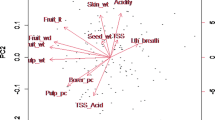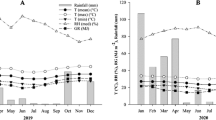Abstract
A key strategy to improve fruit quality and consumer appeal in mangoes is to breed trait improvements into new cultivars. There are several key fruit quality traits in mango. Knowledge of the heritability and relationship among these traits is important for breeding success. This paper implements a linear mixed model analysis including paternal information for analysis of 13 important fruit quality traits from mango cultivars planted across three environments and assessed over several seasons. The traits analysed were average fruit weight, skin background colour, blush colour, percentage blush, blush intensity, skin thickness, beak shape, stem-end shape, deformities, mesocarp colour, mesocarp texture, seed width and mesocarp recovery. The analysis allows investigation into trait heritabilities and stability of traits over years and sites, as well as genetic correlations among traits.






Similar content being viewed by others
Data Availability
The datasets generated analysed during the current study are not publicly available due to commercial in confidence and the protection of intellectual property associated with the Australian National Mango Breeding Program but are available from the corresponding author on reasonable request.
Code availability
Statistical methods and software used in this manuscript are outlined in the materials and methods section.
References
Abe K, Sato Y, Saito T, Kurihara A, Kotobuki K (1995) Narrow-sense heritability of fruit characters in Japanese pear (Pyrus pyrifolia Nakai). Jpn J Breed 45(1):1–5. https://doi.org/10.1270/jsbbs1951.45.1
AMIA (2014) Mango Stratagic Investment Plan 2014/15. AMIA, p 25
Bally IE, Lu P, Johnson P (2009) Mango breeding. In: Jain SM, Priyadarshan PM (eds) Breeding plantation tree crops: tropical species. Springer, New York
Bally ISE (2008) Mango breeding activities in Australia. Paper presented at the 4th international symposium on tropical and subtropical fruits, Bogor, West Java, Indonesia, 3–7 November
Bally ISE, Akem CN, Dillon NL, Grice K, Lakhesar D, Stockdale K (2013) Screening and breeding for genetic resistance to anthracnose in mango. Acta Hort 992:239–244
Bally ISE, De Faveri J, Maddox C (2017) Breeding for low vigour in mango. Acta Hort 1138:63–68. https://doi.org/10.17660/ActaHortic.2017.1183.9
Bally ISE, Dillon NL (2018) Mango (Mangifera indica L.) Breeding. In: Al-Khayri JM, Jain SM, Johnson DV (eds) Advances in Plant Breeding Strategies: Fruits, vol 3 Advances in Plant Breeding Strategies. Springer International Publishing, Cham
Bally ISE, Lu P, Johnson P, Muller WJ, González A (2009) Past, current and future approaches to mango genetic improvement in Australia. Acta Hort 820(1):153–163
Berardini N, Fezer R, Conrad J, Beifuss U, Carle R, Schieber A (2005) Screening of mango (Mangifera indica L.) cultivars for their contents of flavonol O- and xanthone C-glycosides, anthocyanins and pectin. J Agric Food Chem 53(5):1563–1570
Berardini N, Schieber A, Klaiber I, Beifuss U, Carle R, Conrad J (2005) 7-O-methylcyanidin 3-O-b-D-galactopyranoside, a novel anthocyanin from mango (Mangifera indica L. cv. ‘Tommy Atkins’) peels. Z Naturforsch 60:801–804
Bernardo R (2010) Breeding for Quantitative Traits in Plants. Stemma Press, Woodbury, Minn
Butler DG, Cullis BR, Gilmour AR, Gogel BJ (2009) ASReml-R reference manual, release 3. Department of Primary Industries and Fisheries, Brisbane, Australia, Toowoomba, Queensland
Cullis BR, Smith AB, Beeck CP, Cowling WA (2010) Analysis of yield and oil from a series of canola breeding trials. Part II. Exploring variety by environment interaction using factor analysisThis article is one of a selection of papers from the conference exploiting genome-wide association in oilseed brassicas: a model for genetic improvement of major OECD crops for sustainable farming. Genome 53 (11):1002–1016.https://doi.org/10.1139/G10-080
De Faveri J (2013) Spatial and temporal modelling for perennial crop variety selection trials., PhD thesis, University of Adelaide, Adelaide
De Faveri J, Verbyla AP, Pitchford WS, Venkatanagappa S, Cullis BR (2015) Statistical methods for analysis of multi-harvest data from perennial pasture variety selection trials. Crop Pasture Sci 66(9):947–962. https://doi.org/10.1071/CP14312
De Faveri J, Verbyla AP, Lee SJ, Pitchford WS (2017) Maternal body composition in seedstock herds: 5. Animal Production Science, Multivariate analysis using factor analytic models and cluster analysis. https://doi.org/10.1071/AN15465
Dutkowski G, Costa e Silva J, Gilmour A, Lopez G (2002) Spatial analysis methods for forest genetic trials. Canadian Journal of Forest Research 32:2201–2214
Falconer DS, Mackay TFC (1996) Introduction to Quantitative Genetics. Longman Scientific and Technical, London
Gabriel KR (1971) The biplot graphic display of matrices with application to principal component analysis. Biometrika 58:453–467
Galan Saco V (2017) Trends in world mango production and marketing. Acta Hort 1183:351–364
Hansche PE (1986) Heritability of fruit quality traits in peach and nectarine breeding stocks dwarfed by the dw gene. Hortsci 21(5):1193–1195
Hardner C, Bally I, Wright C (2012) Prediction of breeding values for average fruit weight in mango using a multivariate individual mixed model. EUP 168(2):463–477. https://doi.org/10.1007/s10681-012-0639-7
Hofman PJ (1997) What causes green, ripe mangoes? Mango Care Newsletter 20:13–15
Horticulture Innovation Australia (2017) Mango Stratagic Investment Plan 2017–2021. Hort Innovation, Sidney, Australia
Horticulture Innovation Australia (2018) Australian Horticulture Statistics Handbook, Fruit, 2016/2017. Horticulture Innovation Australia, Sydney, Australia
Iyer CPA, Schnell RJ (2009) Breeding and Genetics. In: Litz RE (ed) The Mango Botany, Production and Uses 2nd Edition, 2nd edn. CABI International, Wallingford, Oxen, pp 67–96
Kelly AM, Smith AB, Eccleston JA, Cullis BR (2007) The accuracy of varietal selection using factor analytic models for multi-environment plant breeding trials. Crop Sci 47:1063–1070. https://doi.org/10.2135/cropsci2006.08.0540
Kulkarni VJ, Bally ISE, Brettell RIS, Johnson PR, Hamilton D (2002) The Australian national mango breeding program - in search of improved cultivars for the new millennium. Acta Hort 575(1):287–293
Medlicott AP, Bhogal M, Reynolds SB (1986) Changes in peel pigmentation during ripening of mango fruit (Mangifera indica var. Tommy Atkins). Ann Appl Biol 109:651–656
Meyer K (2007) Multivariate analyses of carcass traits for Angus cattle fitting reduced rank and factor-analytic models. J Anim Breed Genet 124:50–64. https://doi.org/10.1111/j.1439-0388.2007.00637.x
Pott I, Marx M, Neidhart S, Muhlbauer W, Carle R (2003) Quantitative determination of beta-carotene stereoisomers in fresh, dried, and solar-dried mangoes (Mangifera indica L.). J Agric Food Chem 51(16):4527–4531
Proctor JTA, Creasy LL (1969) The anthocyanin of the mango fruit. Phytochemistry 8(10):2018
R Core Team (2015) R: A language and environment for statistical computing. R Foundation for Statistical Computing. https://www.R-project.org/. 2017
Smith AB, Cullis BR, Thompson R (2001) Analysing variety by environment data using multiplicative mixed models and adjustments for spatial field trend. Biometrics. https://doi.org/10.1111/j.0006-341X.2001.01138.x
Smith AB, Stringer JK, Wei X, Cullis BR (2007) Varietal selection for perennial crops where data relate to multiple harvests from a series of field trials. Euphytica 157:253–266
Stringer JK, Cullis BR (2002) Application of spatial analysis techniques to adjust for fertility trends and identify interplot competition in early stage sugarcane selection trials. Aust J Agric Res 53:911–918
The Royal Horticultural Society (2001) RHS colour chart, 4th edn. Royal Horticultural Society, London
Zeinanloo A, Shahsavari A, Mohammadi A, Naghavi MR (2009) Variance component and heritability of some fruit characters in olive (Olea europaea L). Sc Hort 123(1):68–72. https://doi.org/10.1016/j.scienta.2009.07.024
Acknowledgements
We would like to acknowledge the efforts of Peter Johnson, David Hamilton, Chris Wicks, Ping Lu, Richard Brettell, Sam Blakie, Warren Muller and Craig Hardner who contributed to collecting and collation of the phenotypic data used in this analysis. We would like to acknowledge the Queensland Department of Agriculture and Fisheries, the Northern Territory Department of Primary Industry & Resources, the Western Australian Department of Primary Industries and Regional Development and CSIRO for their financial support of the National Mango Breeding project.
Funding
The National Mango Breeding project was supported by the Queensland Department of Agriculture and Fisheries, the Northern Territory Department of Primary Industry & Resources, the Western Australian Department of Primary Industries and Regional Development and CSIRO.
Author information
Authors and Affiliations
Contributions
Both authors contributed to the study conception and design. Material preparation, and data collection was performed by Ian Bally and data analyses were performed by Joanne De Faveri. The first and subsequent drafts of the manuscript were written by Ian Bally and Joanne De Faveri. All authors read and approved the final manuscript.
Corresponding author
Ethics declarations
Conflict of interest
The authors declare that they have no conflict of interest.
Additional information
Publisher's Note
Springer Nature remains neutral with regard to jurisdictional claims in published maps and institutional affiliations.
Rights and permissions
About this article
Cite this article
Bally, I.S.E., De Faveri, J. Genetic analysis of multiple fruit quality traits in mango across sites and years. Euphytica 217, 44 (2021). https://doi.org/10.1007/s10681-020-02750-3
Received:
Accepted:
Published:
DOI: https://doi.org/10.1007/s10681-020-02750-3




